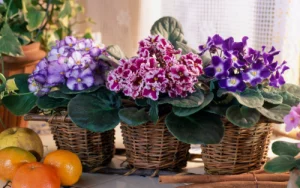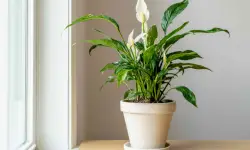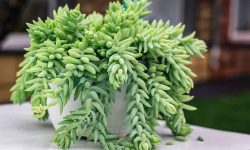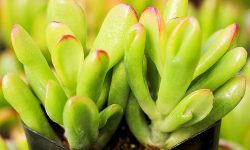I have been an indoor plant enthusiast for two decades and African violet is my favorite houseplant due to its vibrant flowers. These flowers bring a touch of elegance and natural beauty to your indoor space.
Caring for African violets can be a daunting experience for beginners. Understanding how to care for African violet indoors can make your houseplant flourish. We have also shared some challenges and effective solutions to keep it healthy.

Overview of African Violet Care and Problems
Origin |
East Africa |
Scientific Name |
Saintpaulia ionantha |
Common Name |
African Violet |
Maximum Growth (Approx) |
6-12 inches (15-30cm) |
Light Requirement |
Bright indirect sunlight. Direct sunlight will scorch the leaves. |
Watering Requirement |
Water the plant when 2-3 inches of topsoil is dry. |
Temperature Range Requirement |
65°F (18°C)-75°F (24°C) |
Potting Soil Requirement |
Well-draining soil |
Humidity Level Requirement |
The average humidity of 40% and above |
Fertilizer Application Requirement |
Feed your place once or twice with dilute balanced fertilizer every summer and spring |
Flowers |
Purple, Blue, Pink, Red, and White |
Propagation |
Leaf cuttings, Suckers, and division |
Re-potting |
Every two years when the plant display roo-bound symptoms |
Pruning and Maintenance |
Remove the lower yellow or brown leaves |
Pests and Diseases |
Pests: Aphids, mealybugs, spider mites, and thrips. Diseases: Powdery mildew, root rot, and crown rot. |
Toxicity |
Non-toxic to pets and humans |
How to Care for African Violet Indoors
How Much Light Does an African Violet Need?
When it comes to light, African violets require bright and indirect light to thrive. Direct sunlight can scorch their leaves, while insufficient light can lead to weak growth and fewer blooms.
Place your African violet in a location where it receives bright and filtered light for about 8 to 10 hours a day. Avoid placing African violets in direct sunlight during the hottest hours of the day.
If your home doesn’t have enough natural light, you can supplement with fluorescent lights placed 12 to 18 inches above the plant. Regularly rotate the plant to ensure even light exposure.
How Often to Water African Violets
Proper watering is crucial for the health of African violets. These plants prefer slightly moist soil but are susceptible to root rot if overwatered.
It is best to water from the bottom rather than pouring water directly on the leaves or soil. Place the pot in a tray filled with water and let the plant absorb moisture through the drainage holes.
Water your African violet when the top inch of soil feels dry to the touch. Avoid allowing the soil to completely dry out or become soggy. It’s better to underwater slightly than to overwater.
African Violet Temperature Range
African violets thrive in moderate temperatures, ideally between 65°F (18°C) and 75°F (24°C) during the day and slightly cooler at night, around 60°F (15°C) to 70°F (21°C).
Drastic temperature fluctuations can stress the plants and hinder their growth. Avoid placing African violets near cold drafts or in direct contact with heaters or air conditioning vents.
These temperature extremes can lead to leaf damage and impact flowering. Maintain a consistent temperature by placing them in areas with stable ambient temperatures.
African Violet Soil Requirement
The right soil is crucial for African violets as it affects their overall health and growth. These plants require a well-draining soil mix that retains moisture without becoming waterlogged.
A suitable soil mix for African violets consists of a combination of peat moss, perlite, and vermiculite. The peat moss retains moisture, while perlite and vermiculite ensure good drainage.
Incorporating a small amount of organic matter or compost can provide essential nutrients to the plants. Avoid using heavy garden soil or soil mixes intended for outdoor plants.
When repotting African violets, use a potting mix specifically formulated for these plants, or make your own by combining the recommended ingredients in the right proportions.
African Violet Humidity Level
African violets prefer moderate to high humidity levels. Adequate humidity helps prevent the drying out of leaves and promotes healthy growth.
If the humidity in your home is low during the winter months, the indoor heating can cause dry air. You can increase humidity around the plants using an electric humidifier.
Avoid misting the leaves directly, as excessive moisture can lead to fungal diseases. It’s also important to provide good air circulation to prevent the buildup of excess moisture on the plant.
African Violet Fertilizer Application
Regular fertilization is important to provide African violets with the necessary nutrients for healthy growth and abundant blooms. Use a balanced water-soluble fertilizer formulated for African violets or houseplants.
Dilute the fertilizer according to the manufacturer’s instructions and apply it to the soil every 2 to 4 weeks during the growing season. Avoid over-fertilizing since it can lead to salt buildup in the soil and damage the roots.
Always follow the recommended dosage and flush the soil occasionally with plain water to prevent salt accumulation. It is beneficial to use a fertilizer with a slightly higher phosphorus content to promote blooming.
How to Repot African Violets
Repotting African violets is necessary when they outgrow their current containers or when the soil becomes compacted. Here’s a general guideline to repot African violets:
- Choose a pot that is one size larger than the current one, with drainage holes at the bottom.
- Prepare the new pot by adding a layer of fresh, well-draining potting mix at the bottom.
- Gently remove the African violet from its current pot, being careful not to damage the roots.
- Loosen the root ball and remove any dead or damaged roots.
- Place the plant in the new pot and fill the gaps with fresh potting mix, ensuring that the crown of the plant sits slightly above the soil level.
- Firmly press the soil around the roots, but avoid compacting it too much.
- Water the plant from the bottom, allowing it to absorb moisture for about 20 to 30 minutes, and then remove any excess water.
How to Propagate African Violets
Propagating African violets allows you to create new plants from existing ones. Here’s a general guideline for propagating African violets:
- Choose a healthy, mature African violet plant with several leaves.
- Select a leaf from the plant that is free from any damage or disease.
- Using a clean, sharp knife or scissors, cut the leaf at the base, ensuring you have a clean cut.
- Fill a small pot or tray with a well-draining rooting mix, such as a mixture of perlite and vermiculite.
- Make a small hole in the rooting mix using a pencil or your finger.
- Insert the cut end of the leaf into the hole, ensuring the leaf remains above the surface.
- Place the pot or tray in a warm, bright location, but avoid direct sunlight.
- Keep the rooting mix slightly moist by misting it or watering it from the bottom.
- After a few weeks, small plantlets will emerge from the base of the leaf.
- Once the plantlets develop roots and are large enough, carefully separate them from the leaf and transplant them into individual pots.
Pruning and Maintenance
Regular pruning and maintenance help keep African violets healthy, and compact and encourage blooming. Follow these guidelines:
- Remove spent or wilted flowers by gently pinching them off. This promotes new flower bud development.
- Trim yellow or damaged leaves at their base using clean scissors.
- Maintain a bushy appearance by pinching back leggy stems or removing excessive growth. Pinch above a leaf node to encourage branching.
- Rotate the plant regularly to ensure even growth and prevent the plant from leaning toward the light source.
- Clean the leaves occasionally by gently wiping them with a soft, damp cloth to remove dust and maintain their attractive appearance.
Pests and Diseases
African violets are generally resilient plants, but they can be susceptible to a few pests and diseases. Here are some common issues and general guidelines to prevent or manage them:
Aphids and mealybugs: These sap-sucking insects can be controlled by using insecticidal soap or neem oil. Regularly inspect the leaves and stems for any signs of infestation and take prompt action.
Botrytis blight: This fungal disease causes grayish-brown patches on leaves and flowers. Avoid overwatering and improve air circulation to prevent its occurrence. Remove and destroy any infected plant parts.
Crown and root rot: Overwatering and poorly draining soil can lead to these fungal diseases. Ensure proper watering practices and use well-draining soil to prevent rotting. Remove any affected plants to avoid spreading the disease.
Powdery mildew: This fungal disease appears as a white powdery coating on leaves. Maintain good air circulation and avoid overhead watering to prevent powdery mildew. If necessary, use fungicides specifically formulated for African violets.
Final Thoughts from Experts
To care for an indoor African violet plant, it’s essential to maintain a balance of light, water, temperature, soil conditions, humidity, and fertilizer application.
Provide bright indirect light for 8 to 10 hours a day, watering when the top inch of soil is dry, and maintaining a moderate temperature range between 65°F and 75°F. Use a well-draining soil mix, maintain moderate to high humidity levels, and fertilize regularly with a balanced fertilizer.
Repot African violets when necessary, propagate them from healthy leaves to create new plants, and practice pruning and maintenance to promote healthy growth and blooming. Keep an eye out for pests and diseases, and take appropriate measures to prevent or manage them.
People Who Read This Also Read:
- African Violet Leaves Falling Off (Causes & Solutions)
- African Violet Leaves Drooping (Causes & Solutions)
- African Violet Leaves Curling (Causes & Solutions)
- African Violet Leaves Turning Yellow (Causes & Solutions)
- African Violet Leaves Turning Brown (Causes & Solutions)
- Brown Spots on African Violet Leaves (Causes & Solutions)
- African Violet Not Flowering (Causes & Solutions)






